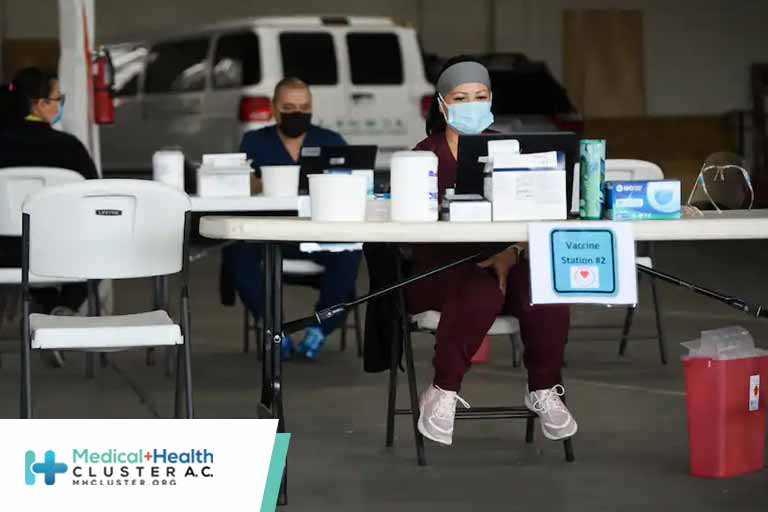En atención a la creciente preocupación sobre la confianza en...
Leer más
U.S. sees significant drop in vaccinations over past week

Vaccinations declined 11 percent, the biggest downturn in the seven-day average since February storms
The downturn hits ashalf of all eligible Americans have receivedat least one vaccine dose.And it coincides with the pause last week of the single-shot Johnson & Johnson vaccine, which is under review by a panel of experts following a handful of cases of severe blood clotting.
Softening demand also appears to be a factor: Scores of counties from Iowa to Texashave begun to decline vaccineshipments, highlighting issues of hesitancy and barriers to health care thatmay hamper efforts to reach the levels of protection needed to halt the spread of the coronavirus.
Officials say they need to ramp up effortsto vaccinate hard-to-reach groups such as rural residents and homebound seniors, answer pointed questions from people leery of side effects and convince young people who don’t fear the virus that they, too, benefit fromgetting vaccinated.
“This will be much more of an intense ground game where we have to focus on smaller events more tailored to address the needs and concerns of focused communities who have different sensitivities and different needs,” said Steven Stack, commissioner of the Kentucky Department for Public Health.
President Biden on Wednesday sought to remove one significant barrier to shots, promising tax credits for employers that give their workers paid time off to receive and recover from inoculations.
“The time is now to open up a new phase of this historic vaccination effort,” Biden said. “To put it simply, if you’ve been waiting for your turn, wait no longer.”
But the White House declined to comment on the weekly data, pointing to the president’s response to a question about whether supply had outpaced demand. “Not yet,” he answered.
Public health officials say the interruption of the J&J vaccineprobably played a role in the downturn, with the shortfall on certain days this week roughly equivalent to the number of J&J doses reported on the equivalent day a week ago.An advisory panel to the Centers for Disease Control and Prevention is expected to make a recommendation on Friday about how, if at all, to move forward with that vaccine.
However, the pause was not the entire explanation, as federal officials said they were able to use more Pfizer-BioNTech and Moderna doses to compensate, while state and county health officers touted their efforts to reschedule patients initially slated to receive Johnson & Johnson’s product with other vaccines.
The Johnson & Johnson pause also did not appear to undermine overall vaccine confidence, according to surveys showing between 65 percent and 70 percent of Americans whosaid they had received or were likely to receive a shot, little changed from before. Some public health officials said the development reassured Americans that the government paid close attention to vaccine safety.
“We have absolutely seen that anyone who was positing the theory that they just quickly threw out these half-baked vaccines and they don’t care even what happens to it have obviously seen that is not the case,” said Ngozi Ezike, director of the Illinois Department of Public Health. “We are much better off than we were before the pause.”
But millions of Americans are still not signing up for shots for a host of other reasons, from wanting to avoid the hassle of finding an appointment to wanting to wait longer for more research on long-term side effects.
Nirav Shah, who leads Maine’s health department and is president of the Association of State and Territorial Health Officials, said public health authorities are starting to turn their attention to those who are not able to get vaccines because they cannot make time or find transportation, as well as those who have “earnest questions” about vaccine safety.
The next stage requires more walk-in vaccination sites, free rides and door-to-door outreach, he said.
“What we’ve all seen in the work that we’ve done is it’s not enough for vaccine to be in a state, it’s not enough for it to be at a vaccination site or at the doctor’s office,” said Shah in a press call highlighting local vaccine efforts.
The slowdown in shots is concentrated in certain parts of the country, exacerbating the regional divides in vaccinations.
The declines are especially acute across states in the Deep South that already have some of the lowest vaccination rates. Average daily shots plunged by more than 30 percent in Georgia and South Carolina over the past week. Texas reported a 25 percent decline with about 30 percent of its eligible population inoculated.
Butthe steepest declines have been among small states with relatively high penetration of the vaccines: Maine, Alaska and New Hampshire.
Average daily vaccinations are still climbing, meanwhile, in Delaware, California, Hawaii, Kentucky and Utah, in addition to the District of Columbia and Puerto Rico.
Some counties with as few as a quarter of eligible residents fully vaccinated are seeing steady or even increasingcoronavirus infections, a harbinger of how inadequate coverage could allow the virus to spread. Most are relatively rural and overwhelmingly Republican. Health officials in these places said they had not expected such anti-vaccine antipathy.
Philip Keiser, the top health official in Galveston County on the Gulf Coast of Texas, asked the state not to send him new vaccine supply this week as he plans more targeted outreach, including events in hard-to-reach communities and at schools. About a third of eligible residents have been fully vaccinated, according to state data.
Créditos: Comité científico Covid






